
A postage stamp is a small piece of paper issued by a post office, postal administration, or other authorized vendors to customers who pay postage. Then the stamp is affixed to the face or address-side of any item of mail—an envelope or other postal cover —which they wish to send. The item is then processed by the postal system, where a postmark or cancellation mark—in modern usage indicating date and point of origin of mailing—is applied to the stamp and its left and right sides to prevent its reuse. Next the item is delivered to its addressee.
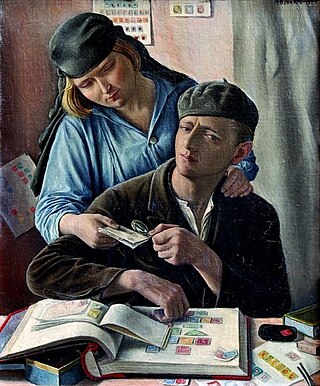
Stamp collecting is the collecting of postage stamps and related objects. It is an area of philately, which is the study of stamps. It has been one of the world's most popular hobbies since the late nineteenth century with the rapid growth of the postal service, as a never-ending stream of new stamps was produced by countries that sought to advertise their distinctiveness through their stamps.

Philatelic literature is written material relating to philately, primarily information about postage stamps and postal history.

The Penny Red was a British postage stamp, issued in 1841. It succeeded the Penny Black and continued as the main type of postage stamp in the United Kingdom of Great Britain and Ireland until 1879, with only minor changes to the design during that time. The colour was changed from black to red because of difficulty in seeing a cancellation mark on the Penny Black; a black cancellation mark was readily visible on a Penny Red.
This is a list of philatelic topics.

This is an overview of the postage stamps and postal history of Australia.
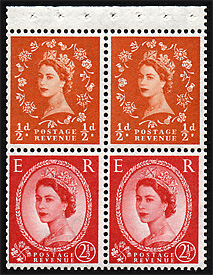
The Wildings were a series of definitive postage and revenue stamps featuring the Dorothy Wilding photographic portrait of Queen Elizabeth II that were in use between 1952 and 1971. The Wildings were the first and only British stamps to feature graphite lines on the back, and the first to feature phosphor bands on the face – both aids to automation. The stamps were also the first British pictorial high value stamps and the first to include regional emblems.

A variable value stamp is a gummed or self-adhesive postage stamp of a common design, issued by a machine similar to an automatic teller machine (ATM), with a value of the user's choice printed at the time the stamp is dispensed. The value may be variable or from a fixed selection of postal rates. The stamps and machines are typically for use in retail or post office environments. As only the postal value varies from stamp to stamp, these stamps have been described as key type stamps. They are also closely related to meter stamps from postage meters.

The postage stamps and postal history of Azerbaijan describes the history of postage stamps and postal systems in Azerbaijan, which closely follows the political history of Azerbaijan, from its incorporation to the Russian Empire in 1806, to its briefly obtained independence in 1918, which it lost to the Soviet Union in 1920 and re-acquired in 1991 after the fall of the Soviet Union.

Bahrain first used the postage stamps of British India before eventually issuing its own stamps in 1960.

A meter stamp, or meter mark, is the impression made by a postage meter machine that indicates that postage has been paid on a letter or parcel. Meter stamps are widely used by businesses and organisations as they are more efficient than using postage stamps.

St. Lucia a former British dependency in the Windward Islands began using stamps in 1860. It achieved Associated Statehood on 1 March 1967. In 1979, it gained independence.
This is a survey of the postage stamps and postal history of Brunei.

This is a survey of the postage stamps and postal history of Liechtenstein.
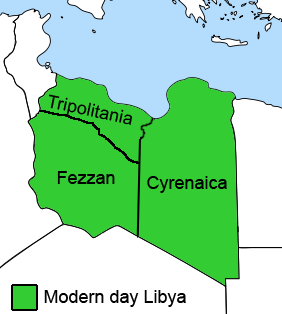
This is a survey of the postage stamps and postal history of Cyrenaica, now part of Libya.

This is a survey of the postage stamps and postal history of Libya. Libya is a country located in North Africa. Bordering the Mediterranean Sea to the north, Libya lies between Egypt to the east, Sudan to the southeast, Chad and Niger to the south, and Algeria and Tunisia to the west.
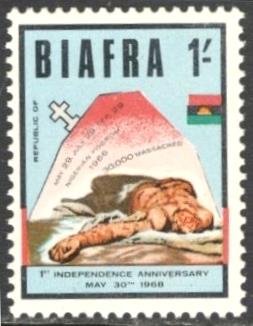
This is a survey of the postage stamps and postal history of Biafra.

The first postal service took place using mail sent with captains of packet ships, using agents in the England and in the islands for the end delivery. The cost was normally 3d. The first pillar boxes in Britain were introduced in the Channel Islands as an experiment in 1852, to collect mail for the Royal Mail packet boats. The oldest pillar box in use in the British Isles is in Guernsey.
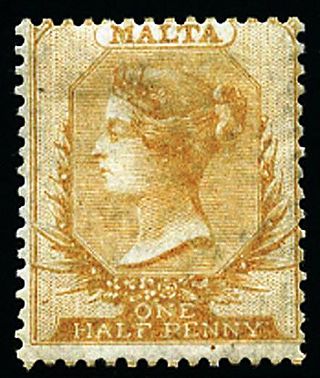
The Halfpenny Yellow is the first postage stamp issued by the Crown Colony of Malta. Depicting Queen Victoria, it was only valid for local postage and it was originally issued on 1 December 1860. It was the only stamp issued by Malta for two and a half decades, and during this period various reprints were made with differences in colour shade, perforation and watermark. When control of Malta's postal service was transferred to the island's colonial government on 1 January 1885, the stamp was withdrawn and it was replaced by a set of definitive stamps.

Tagging of postage stamps means that the stamps are printed on luminescent paper or with luminescent ink to facilitate automated mail processing. Both fluorescence and phosphorescence are used. The same stamp may have been printed with and without these luminescent features, the two varieties are referred to as tagged and untagged, respectively.